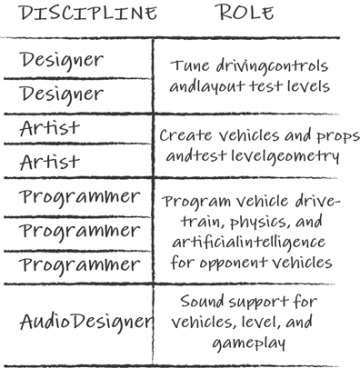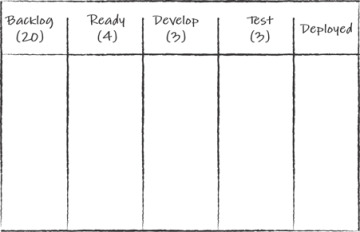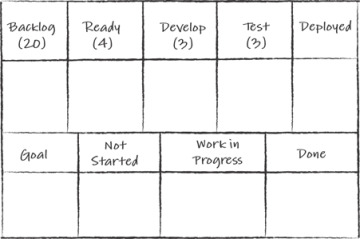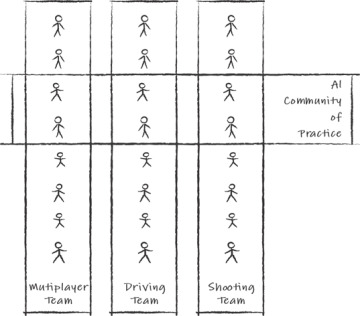- The Solutions in This Chapter
- Challenges to Scaling
- Should You Scale Up?
- Scaling the Wrong Process
- The MAGE Framework
- The Product Backlog
- Team Organization
- Product Ownership
- Additional Roles
- Releases
- Sprints
- Managing Dependencies
- Distributed and Dispersed Development
- What Good Looks Like
- Summary
- Additional Reading
Team Organization
A fundamental Scrum principle is the formation of teams that are self-contained and can genuinely commit to owning their Sprint goals. This leads to cross-functional teams that include artists, programmers, and designers for core game features. However, some self-contained teams might need fewer disciplines, perhaps even one, to accomplish something of value.
This section lists a variety of team types used for Agile game development. Not all of these team types are necessary for your game.
Feature Teams
Feature teams are cross-disciplined teams that develop core game features. For example, the small cross-disciplined team shown in Figure 21.4 could take full responsibility for a driving mechanic.

Figure 21.4 An example driving mechanics team
A significant benefit of feature teams is the sense of ownership they experience. Participating in the full development of a few mechanics is far more satisfying to most developers than attending part-time on many. For many developers, this gives a greater sense of accomplishment.
A feature team should have everyone it needs to build the mechanics. In practice, this is difficult to accomplish. Sometimes teams need to share disciplines in short supply. An example of this is an effects (FX) artist who is utilized 25 percent of the time by any single team. Often this person is shared among multiple teams.
Component Teams
Component teams are composed of developers who work on a component of the game, such as a rendering engine or content area. Although less common than feature teams on an Agile project, component teams have their benefits. One example is a platform team comprised mostly of programmers. These programmers are experts in optimizing performance for a particular platform such as the iPhone or Android. Concentrating these individuals on a single team focuses effort on challenging problems that are wasteful for feature teams to solve on their own. For example, if the iPhone programmers are spread across multiple teams, then their efforts creating a working iPhone build are diluted.
Component teams are typically used only for foundational or services work. Using component teams for work that impacts multiple mechanics often leads to less suitable solutions for the game. For example, a component team was formed to create the character AI for a game. This team consisted of AI programmers who wanted to develop the best-architected AI possible. Unfortunately, their efforts led to AI functionality that was handed off to other teams that neither understood how the AI worked nor benefitted from many of the features designed into it. Ultimately this team broke up, and the AI programmers scattered across the project to implement AI needed by various teams.
Production Teams
Production teams are cross-discipline teams used for game development projects that have a production phase. These teams have a more defined pipeline of work for creating specific content and applying some of the Lean and Kanban practices described in Chapter 6. Production teams are also less bound by the five-to-nine-member team sizes due to the more predictable flow of work.
Production teams may exchange members as needed with other production teams to maintain a steady flow of asset creation. Production teams often form from feature teams as a mechanic transitions from pre-production to production. For example, most of the programmers might leave the level pre-production team as it enters production and be replaced with more modelers, texture artists, and audio designers. Example production teams include:
Level production
Character production
Cinematics
Community website
Support Teams
A frequently asked question is how support teams should organize themselves in an Agile project environment. Because they support multiple teams, they receive requests for features that cannot be as easily ordered as they are for a single team, which can create confusion and conflict between the support team and its “customers,” the games that depend upon them.
A support team requires their own Backlog and Product Owner. Having more than one Backlog and one Product Owner for a support team is a recipe for disaster. The team should have every benefit that other Agile teams have in an understandable Backlog and single vision. Customer teams should identify priorities during Release Planning and include the support team (or at least its lead and Product Owner) in their Release Planning.
Support Kanbans
Support teams often benefit from using Kanban over Sprints, which allows them to be more responsive to urgent requests for bug fixes or other impediments to teams that use their services. Figure 21.5 shows a simple Kanban board for a support team.

Figure 21.5 A Kanban board example for a support team
One of the most critical metrics is the average amount of time it takes between a support request to be received and when it is deployed. Support teams always try to find a way to reduce this response time.
Note that even the Backlog has a work in progress (WiP) limit, which is meant to force the Product Owner to refine the Backlog from time to time so older requests don’t pile up and reduce response times. This also helps the teams asking for support to refine and prioritize their requests continually.
The ready state on the board represents the requests that the team has tasked out and are ready to be worked on. When the last request is pulled into the develop column by the team, the empty state of the column signals the members to have a planning session soon and to fill up that column with four new features, tasked out, as indicated by the WiP number.
Support Team Iteration Goals
Support teams can also have iteration goals. This is common with engine and tools teams, which have research and development (R&D) goals of their own. In these circumstances, a Sprint swim lane (see Figure 21.6) can be added below a Kanban lane. The team would determine how much time it could dedicate to each lane per Sprint and judge how much of a goal to forecast in Sprint Planning.

Figure 21.6 An example Kanban board with a Sprint swim lane
Managing Maintenance and Quality Issues
Support teams should factor in emergent support work. Setting aside a certain percentage of your bandwidth for unexpected maintenance is critical. It’s easy to track how much time is being spent addressed on maintenance work every Sprint and subtract that from your planning capacity.
Tool Teams
A tool team consists of tool creators (programmers, technical artists, QA) whose customers are users of a common toolset and pipeline.
Like a support team, a tool team often supports multiple projects and has its own Product Backlog.
Tool teams have the added benefit of releasing tools to customers who are in the same building, not just stakeholders who represent them. Having tool users who can participate in Backlog definition, prioritization, planning, and reviews is a significant benefit to the tool developers. Tool development can be even more exploratory than game development and benefits substantially from using an Agile approach.
Pool Teams
A pool team is a collection of developers from a single discipline. Unlike other teams, they don’t have their own Sprint Goals. They exist to support teams that do. Examples of this are a pool of animators that could support a feature team that needs a large number of animations in a single Sprint.
Another benefit of a pool team is to provide a service center for art production, also referred to as insourcing. Environment artists and animators are in higher demand during production, and pool teams help level the developer requirements in a larger development studio.
Pool teams require more planning and management during a release to ensure that they are fully utilized. Pool teams are commonly used in late pre-production or production.
Integration Teams
Sharing a vision on larger projects that contain more than 40 developers is challenging. The vision among separate teams can drift, even with a hierarchy of Product Owners. As a result, some projects have “integration teams” that integrate mechanics, developed initially by feature teams, into a unified experience.
These teams are similar in structure to feature teams. The difference is that they are responsible for the overall theme of the game. For example, in an action racing game, eventually the core team takes over the driving mechanics from the team that developed it after it is mature enough. From this point forward, the core team modifies and maintains the mechanic to seamlessly work with the other mechanics.
Feature Area Teams
Feature area teams are a blend of feature teams and component teams that create base features in a specific area for integration teams to assimilate into the game. An example of this is a physics feature team that would create vehicles, destructibles, cloth, and many other physics-based features for a game, but not bring them to a deployable state.
There were two reasons we introduced these teams. First, on large projects, having many feature teams make deployable features led to a divergent feel across those features. Handing the final polish off to an integration team led to a more cohesive look and feel to the game. Second, this allowed these teams to stay together longer. After this, they were able to stay together and move on to another physics-based feature.
Feature area teams are still cross-discipline, needing artists, designers, programmers, and so on to achieve their goals.
Communities of Practice
Another challenge created by large Scrum projects is the potential loss of communication caused by the separation of discipline, or functional expertise, across multiple cross-discipline teams. For example, if all the graphics programmers are spread across various teams, what is to prevent them from solving the same graphics problems in different ways?
The solution is to establish communities of practice that can share knowledge and eliminate the duplication of effort. Figure 21.7 shows how the AI programmers from across multiple Scrum teams can form an AI community of practice.

Figure 21.7 An AI community of practice
Each community can decide how frequently it needs to meet and address the issues it is facing. The AI community might discuss common solutions it could implement. The Scrum Masters can form a community to share improvements to their team’s practices. The designers could create a community to complain about everyone else.2
Communities of practice do not have their own Sprint Goals or assign work outside their teams. Their only purpose is to share information.
